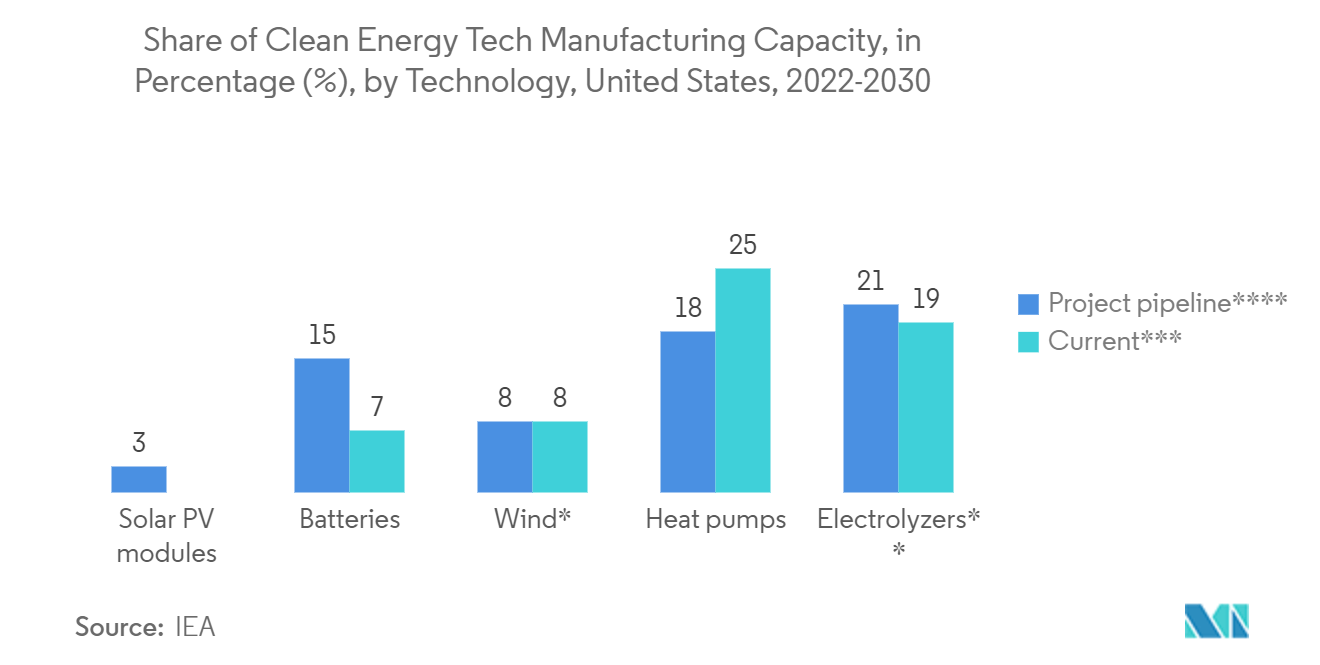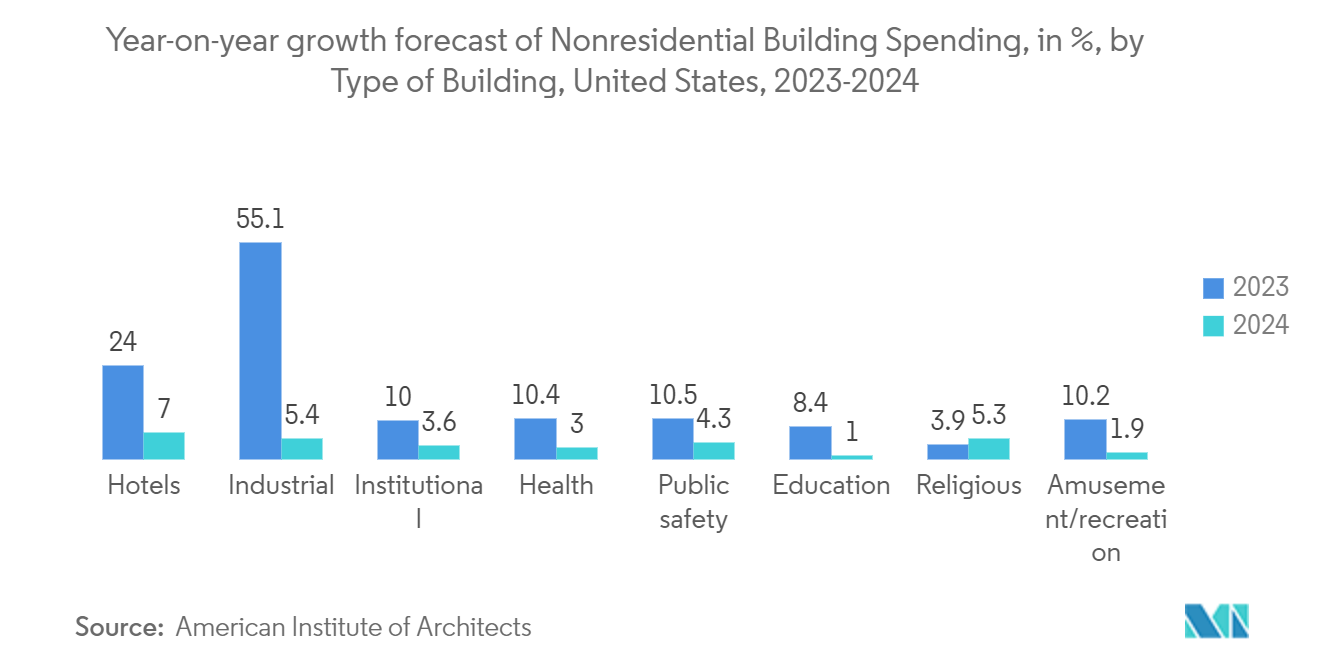Market Trends of North America Facility Management Industry
Hard FM Services are Expected to Hold Significant Share the Market
- Hard facilities management services refer to mechanical services that cannot be removed and are usually structured within the building. Hard services mainly include heat, ventilation, and air-conditioning (HVAC) maintenance; lift and escalator maintenance; mechanical, electrical, and plumbing (MEP) services, decoration and refurbishment; fire safety system maintenance; drainage; building management systems (BMS); total energy management, emergency generation; UPS system, and project management.
- Moreover, complex facility management ensures that all electrical and mechanical equipment is regularly serviced and maintained for optimum efficiency and safety. Another crucial role of this type of facility management is power system services, including normal power, switchgear, electrical substations, standby generators, and emergency power systems.
- One of the principal benefits of hard facility management is creating and operating a planned maintenance schedule across all areas of facility management. For instance, it significantly enhances the energy efficiency of buildings by choosing the most effective supplier and reducing heat loss from premises. As a result, this type of facility management service can lengthen a premise's operational lifespans and reduce the risk of minor problems escalating into costly incidents.
- In the region, the increasing demand for on-site electrical and mechanical solutions in both the commercial and industrial sectors makes electromechanical and operational maintenance account for a significant market share in revenue. Additionally, the need for fire and security systems, which must be placed by law in every structure, has contributed to increased regional development.
- In 2022, the United States had a seven percent share of the worldwide installed production capacity for batteries, as stated by IEA. If all projects that have been announced worldwide actually happen, this percentage would rise to 15 by the year 2030. In 2022, the United States had a 25 percent share of the world's heat pump manufacturing capacity.
- Further, the United States Energy Information Administration's (EIA) Residential Energy Consumption Survey (RECS) estimations stated that 76 million primarily occupied United States homes (64% of the total) use central air-conditioning devices. About 13 million households (11%) utilize heat pumps for heating or cooling equipment.
- By 2023, all new residentials air-conditioning and air-source heat pump devices marketed in the United States will require fulfilling the latest energy efficiency standards, fueling the rise of HVAC services. The rising use of air conditioners, in houses and offices around the United States will be one of the drivers stressing the need for hard facility management services in the region.
- Moreover, the growing regional collaborations with other end-user industries also contribute to the market growth. For instance, in 2022, ATCO Frontec, a part of the ATCO group, was selected to perform maintenance and operational work on 15 NDND installations across Alberta, including armories, training camps, and military museums. The five-year contract was awarded on behalf of DND to Defense Construction Canada DCC, a Crown corporation providing federal infrastructure and environmental protection services.
- According to New York State Energy Research and Development Authority, for the first time, heat pumps - electrically powered and highly efficient devices that deliver heating and cooling - topped gas-powered furnaces in total units sold in the U.S. Americans bought more than 4.3 million heat pump units in 2022, compared to roughly 3.9 million natural gas furnaces. Modern cold-climate heat pumps are a smarter, more efficient, and environmentally friendly option to keep homes comfortable without using fossil fuels. Heat pumps extract heat from the air, ground, or water and transfer it inside a building for heating and outside for cooling. Such a huge number of sales would drive the market.

Commercial Segment is Expected to Hold Significant Share of the Market
- The facility management service market's growth in the United States is attributed to the increasing need for customized solutions for different outsourced and in-house facility management services. Moreover, the rising number of commercial buildings in major cities further drives the nationwide need for facility management services.
- Additionally, increased infrastructure development and the increasing focus on integrated facility management services will drive the market's growth. Investors highly demanded modern offices with long-term tenants despite all the discussions surrounding hybrid work culture. The growing business acumen among industry players and diversification of the economy from automobile sector to other industry avenues is expected to increase the demand for facility management services.
- Various retail businesses are expanding their presence by opening new stores in the United States, creating demand for soft FM services. For instance, in April 2023, IKEA store owner Ingka Group announced a plan to spend EUR 2 billion (USD 2.2 billion) to expand in the United States over the next three years. With this plan, the company finalized to open eight new big IKEA stores and nine smaller stores and upgrade existing stores in the US, which is IKEA's second-biggest market by sales after Germany.
- Further, in June 2022, ISS announced that it had been awarded a 5-year contract to provide integrated facilities management services with a major US retailer. ISS will provide integrated facilities management services across retail, office, and industrial space. This contract represents around 1% of our Group revenue. Such long term contracts would drive the market to grow.
- Accoding to American Institute of Architects, based on short-term projections, the U.S. non-residential construction market is expected to grow by approximately 19.7% in 2023. In 2023, growth is expected to be the largest in industrial construction, with a year-on-year change close to 55%, and the lowest for religious buildings, which are expected to grow by roughly five percent. Such huge rise in non residential construction is expected to drive the demand for the studied market.


